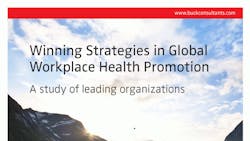For workplace health promotion and wellness programs to succeed globally, senior management must be convinced that these programs provide value to the business – such as boosting productivity or improving safety – in all regions of the world. Although such programs rapidly are growing worldwide, lack of employee trust and buy-in are among the greatest potential impediments to global success.
A new report from Buck Consultants, a Xerox Co., delves into some of the most successful multinational workplace health promotion programs, profiling 13 large multinational employers such as Intel, Novartis and Chevron, which collectively represent over 1 million employees.
“Wellness programs cannot survive in today’s economy without a strong linkage to business goals, and high levels of employee participation and engagement,” says Barry Hall, principal, Buck Consultants. “Although many organizations have achieved some success with single-country programs in the United States or elsewhere, the challenges of globalizing these programs are significant, due to differing cultures, attitudes, regulations and business practices around the world.”
The new report, “Winning Strategies in Global Workplace Health Promotion: A study of leading organizations,” complements the trends identified in Buck’s Global Survey of Health Promotion and Workplace Wellness Strategies to uncover proven strategies that can benefit companies seeking to globalize workplace wellness programs. Buck partnered with International Health Consulting (IHC) to complete the research with support from Integrated Health.
The report identifies eight critical success factors for organizations implementing global health promotion, based on the major commonalities uncovered among the 13 participating companies: Chevron, Dow Chemical, DuPont, Eaton, Goldman Sachs, IBM, Intel, John Deere, Johnson & Johnson, MOL Group, Novartis, Novo Nordisk and Scania. These success factors include:
Focus on value: Articulate a value proposition that has sufficient emphasis on health and well-being factors, in addition to the financial business case. A successful global health strategy recognizes that employee health and wellbeing is a desirable corporate asset – one that impacts everything from recruitment and retention to engagement and employee productivity.
For example, Intel has correlated worker productivity with health metrics such as weight and blood pressure. As a result, their employee health and wellness programs are increasingly designed to focus on addressing these health factors.
Communicate goals and benefits: Spend adequate time and effort explaining to employees the reasons, goals and benefits for providing a health promotion program. Recognize that not every employee accepts the notion that their employer should be concerned about or involved in their personal health and lifestyle, especially in countries where health benefits are provided by the government.
Novartis avoids references to diseases, and instead focuses on positive health behaviors such as exercise, diet and avoiding tobacco. They believe that this “de-medicalized” approach is accepted by employees because they are less likely to feel that the company is prying into their personal health data.
Leverage personal connections: Engage local resources for cultural adaptation and implementation. Success requires a balance between global strategy and local autonomy. Programs managed by local staff with personal connections will outperform programs that are activated through central corporate offices.
Chevron, for example, has “cardio champions” in West Africa – union or general employees who function as ambassadors for the company’s wellness programs by educating their co-workers and encouraging them to participate.
“The research also revealed that each of the organizations profiled had senior-level support that served as a strong organizational driver in their health promotion strategies,” said Wolf Kirsten, president, IHC. To illustrate this point, the report highlights the commitment of several of the companies’ senior executives who strive to lead by example, such as the Novo Nordisk CEO who participates in an annual 105-mile bike ride with a group of 20 employees selected by lottery each year.
Additional research in the report looks at regional and cultural challenges, employee communication strategies, the use of technology in wellness, the influence of corporate culture, motivating and measuring employee participation, tracking global program metrics and scorecards, and emerging areas of focus in global health promotion.
Eight Strategies
The researchers suggest that employers address each of the eight commonalities required to achieve success in global health promotion within their global health promotion strategy.
1. Establish a shared global value proposition, in alignment with key business goals. Ensure metrics are globally consistent and locally relevant.
2. Articulate a value proposition that has sufficient emphasis on health and well-being factors, in addition to the financial business case.
3. Spend adequate time and effort explaining to employees the reasons, goals and benefits for providing a health promotion program.
4. Drive a global strategy through a central or corporate function that provides guidance and technical support to local sites and business units.
5. Engage local resources for cultural adaptation and implementation. Actively utilize local health professionals to help drive strategies regionally and function as a link between corporate and local sites and business units.
6. Provide global access to a core suite of health promotion programs and policies.
7. Establish a healthy workplace index and/or menu of services toward which all sites should strive, and eventually be held accountable.
8. Analyze and address the psychosocial working environment, as well as how work is organized, in order to improve mental health and wellbeing of employees.
The full report is available for a cost from Buck’s Global Survey Resources.
About the Author

Sandy Smith
Sandy Smith is the former content director of EHS Today, and is currently the EHSQ content & community lead at Intelex Technologies Inc. She has written about occupational safety and health and environmental issues since 1990.
